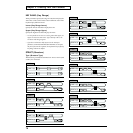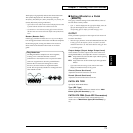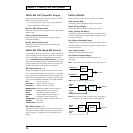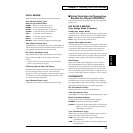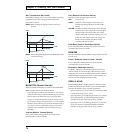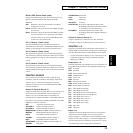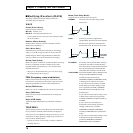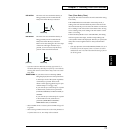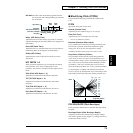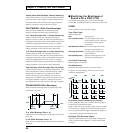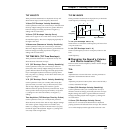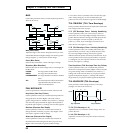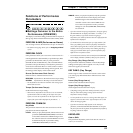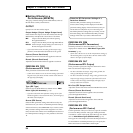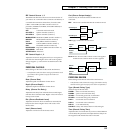
78
Chapter 3. Creating Your Own Sounds
■ Modulating Sounds (LFO)
The LFO (Low Frequency Oscillator) creates cyclic change.
Each Tone has two LFOs, and these can be used to apply
change to the WG Pitch/TVF Cutoff Frequency/TVA Level/
TVA Pan.
LFO1/LFO2
Since both LFOs have the same parameters, there are
explained here together.
Form (LFO Form)
Select the waveform of the LFO.
fig.3-36.e
Key Sync (LFO Key Sync)
Specifies whether you want the LFO cycle to start in sync
with the timing of a key press (ON) or not (OFF).
Rate (LFO Rate)
Adjust the modulation rate of the LFO.
* If you have set the External Sync value to CLOCK, this
parameter will indicate a note value in multiples of a quarter
note, and the corresponding note value symbol will also be
displayed. This allows you to set the LFO rate in terms of a note
length in the synchronization tempo.
* The Chaos waveform has no wavelength. When the Chaos
waveform is selected, the Rate setting has no effect.
ExtSync (LFO External Sync)
Select how the LFO will be synchronized.
OFF: Unsynchronized
CLOCK: Synchronize the LFO to the Patch Tempo,
Performance Tempo, or the tempo clock of the XP-
30’s system.
If you want to use a fixed tempo in Patch mode
(Tempo parameter setting), set the Source
parameter (PATCH/COMMON/PATCH
CLOCK) to PATCH and set the desired tempo.
If you want to use the system’s tempo clock in
Patch mode, set the Source parameter (PATCH/
COMMON/PATCH CLOCK) to SYSTEM.
If you want to use a fixed tempo in Performance
mode (Tempo parameter setting), set the Source
parameter (PERFORM/COMMON/PERFORM
CLOCK) to PERFORM and set the desired tempo.
If you want to use the system’s tempo clock in
Performance mode, set the Source parameter
(PERFORM/COMMON/PERFORM CLOCK) to
SYSTEM.
Mode (LFO Fade Mode)
Select how the LFO will be applied.
ON-IN: The LFO will fade in after the key is pressed.
fig.3-37.e
ON-OUT: The LFO will be immediately applied when the
key is pressed, and will then fade out.
fig.3-38.e
OFF-IN: The LFO will fade in after the key is released.
fig.3-39.e
How to Use the LFO
Applying LFO to the Pitch creates vibrato, applying it to
TVF Cutoff Frequency creates wah, and applying it to TVA
Level creates tremolo. When LFO is applied to the TVA
Pan, the stereo location of the sound will change cyclically.
Depending on the settings, LFO can be used to cyclically
exchange two Tones. For example if you wish to shift
back and forth between Tones 1 and 2, select the same
LFO settings for both, but make LFO Depth settings of
opposite polarity (+/-) for their TVA Level settings.
TRI SIN SAW SQR
TRP S&H RND CHS
chaos wave
triangle wave sine wave sawtooth wave square wave
trapezoidal wave sample &
hold wave
random wave
key is
pressed
high (more)
low (less)
WG Pitch /
TVF Cutoff Frequency /
TVA Level / TVA Pan
Delay
Time
Fade
Time
Depth
key is
pressed
high (more)
low (less)
WG Pitch /
TVF Cutoff Frequency /
TVA Level / TVA Pan
Delay Time Fade Time
Depth
high (more)
low (less)
WG Pitch /
TVF Cutoff Frequency /
TVA Level / TVA Pan
Delay
Time
Fade
Time
Depth
key is
pressed
key is
released



